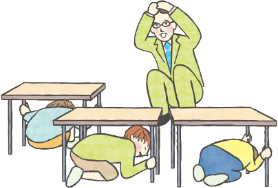


地震防災教育プログラム(英語版)
Earthquake evacuation drills are conducted annually in schools across the country. However, are these drills merely initiated by teachers' instructions such as, “Get under your desk”? This educational program was developed to promote disaster preparedness by cultivating students’ capacity to make independent and proactive decisions in response to sudden, large-scale earthquakes.
※このプログラムは、本ページで掲載している地震防災教育プログラム(日本語)を英語翻訳したものです。

概要
This program is a disaster education curriculum composed of three steps: (1) Pre-learning to acquire accurate knowledge about Earthquake Early Warnings (EEWs), (2) Response Action Training to develop the ability to take appropriate and self-directed action after receiving an EEW, and (3) Post-learning (Reflection) to assess the extent to which the learning objectives have been achieved. The program was developed and refined based on actual classroom implementation by many teachers, with continuous improvement through evaluation of learning outcomes. To ensure adaptability for individual schools, all teaching materials are provided in editable file formats that allow modification and duplication.
プログラムの構成
単元構成
Unit Structure
● Step 1: Pre-learning
Learning Objectives:
1.Understand the basic concepts of Earthquake Early Warning (EEW).
2.Learn how objects move during an earthquake and consider how to respond when hearing an EEW.
3.Learn the rules for moving to a safe location (evacuation).
● Step 2: Response Action Training
Learning Objective:
1.Apply knowledge from the pre-learning step and acquire the ability to take appropriate, self-directed protective actions upon receiving an EEW.
● Step 3: Post-learning (Reflection)
Learning Objectives:
1.Reflect on one’s own behavior and actions during the response drill.
2.Reaffirm appropriate actions to take when hearing an EEW.
3.Understand the importance of protecting oneself during an earthquake.
Step 1: Pre-learning
Learning the right way to respond to an Earthquake Early Warning
Learning Objectives:
1.Understand the basic concepts of Earthquake Early Warning (EEW).
2.Learn how objects move during an earthquake and consider how to respond when hearing an EEW.
3.Learn the rules for moving to a safe location (evacuation).
Step 2: Response Action Training
Drill Based on Earthquake Early Warning (EEW)
Learning Objective:
1.Apply knowledge from the pre-learning step and acquire the ability to take appropriate, self-directed protective actions upon receiving an EEW.
Drill Programs
Step 2 – Drill Program (45 minutes):
A standard drill covering the full process: protective actions, evacuation procedures, and post-drill feedback.
Step 2 – Short Unannounced Drill (5 minutes):
A surprise drill focusing solely on immediate protective actions, without prior time announcement.
Drill Procedure (Example: Short Drill Conducted During Recess)
A chime is broadcast over the school PA system.
1.Students take protective action on their own judgment, wherever they are.
2.An earthquake sound effect is played.
3.Teachers confirm evacuation routes and procedures.
4.An announcement signals the end of the drill.
5.Students return to their classrooms and engage in reflection activities (Step 3).
Note:
During the drill, teachers should not give direct instructions such as “Get under your desk,” in order to encourage students to act based on their own judgment.
(Exceptions may be made for students who require support.)
Step 3: Post-learning (Reflection)
Reflecting on Our Response to the Earthquake Early Warning
Learning Objectives:
1.Reflect on one’s own behavior and actions during the response drill.
2.Reaffirm appropriate actions to take when hearing an EEW.
3.Understand the importance of protecting oneself during an earthquake.
※ダウンロードファイルは、圧縮ファイル(ZIP形式)になっていますので、解凍してご利用下さい。
※解凍したファイルは、Word及びPowerPoint形式です。プログラムの複製(コピー)、修正は自由です。
※本プログラムは、学校防災教育の支援を目的として提供しています。学校現場以外での使用は禁じます。(目的外使用の禁止)

活用事例
中学校の防災学習に「YOU@RISK子ども版-洪水」が活用されました(岩手県洋野町立大野中学校)
- #YOU@RISK
- #中学生
- #洪水
視覚障害のある児童生徒を対象とした竜巻防災教育プログラムの実践事例(栃木県立盲学校)
- #特別支援学校
- #竜巻
- #視覚障害
生徒主体で進める洪水防災教育プログラムの実践事例(新潟県村上市立村上東中学校)
- #YOU@RISK
- #中学校
- #洪水
知的障害のある児童生徒を対象とした竜巻防災教育プログラムの実践事例(栃木県立今市特別支援学校)
- #特別支援学校
- #知的障害
- #竜巻
那須岳周辺地域の火山防災教育プログラムの実践事例(栃木県那須町立那須中学校校)
- #YOU@RISK
- #中学校
- #実践的な防災教育の手引き(中高編)
- #火山
現場の先生による大雨(洪水)防災教育プログラムの実践事例(新潟県長岡市立千手小学校)
- #YOU@RISK
- #小学校
- #洪水

活用事例をお寄せください
本サイトでは、防災教育プログラムの活用事例や、先生方が工夫を凝らして実践された防災教育の取り組みを募集しております。ご投稿いただいた事例は、内容を確認のうえ、「活用事例」ページで紹介させていただく場合がございます。どうぞお気軽にお寄せください。





